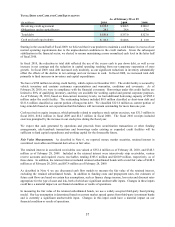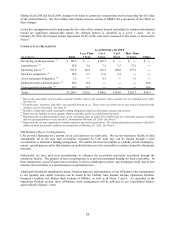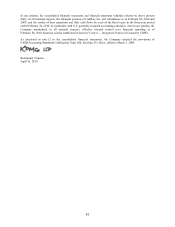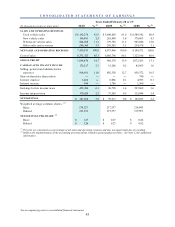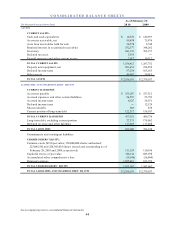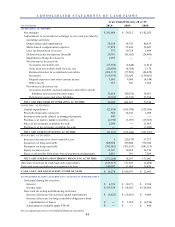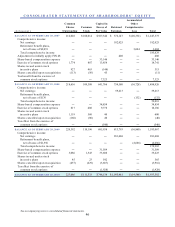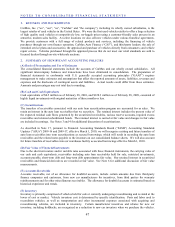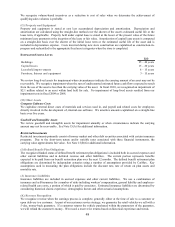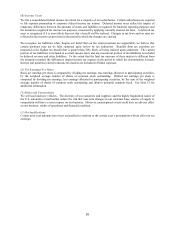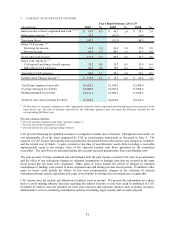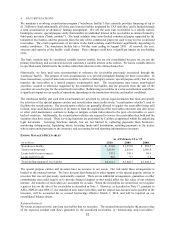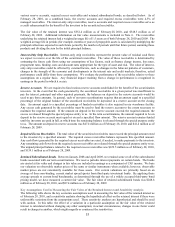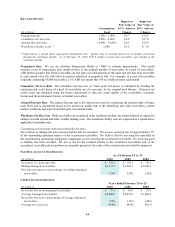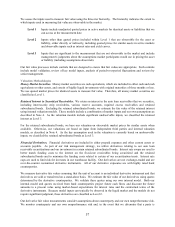CarMax 2010 Annual Report Download - page 57
Download and view the complete annual report
Please find page 57 of the 2010 CarMax annual report below. You can navigate through the pages in the report by either clicking on the pages listed below, or by using the keyword search tool below to find specific information within the annual report.
47
NOTES TO CONSOLIDATED FINANCIAL STATEMENTS
1. BUSINESS AND BACKGROUND
CarMax, Inc. (“we”, “our”, “us”, “CarMax” and “the company”), including its wholly owned subsidiaries, is the
largest retailer of used vehicles in the United States. We were the first used vehicle retailer to offer a large selection
of high quality used vehicles at competitively low, no-haggle prices using a customer-friendly sales process in an
attractive, modern sales facility. At select locations we also sell new vehicles under various franchise agreements.
We provide customers with a full range of related products and services, including the financing of vehicle
purchases through our own finance operation, CarMax Auto Finance (“CAF”), and third-party lenders; the sale of
extended service plans and accessories; the appraisal and purchase of vehicles directly from consumers; and vehicle
repair service. Vehicles purchased through the appraisal process that do not meet our retail standards are sold to
licensed dealers through on-site wholesale auctions.
2. SUMMARY OF SIGNIFICANT ACCOUNTING POLICIES
(A) Basis of Presentation and Use of Estimates
The consolidated financial statements include the accounts of CarMax and our wholly owned subsidiaries. All
significant intercompany balances and transactions have been eliminated in consolidation. The preparation of
financial statements in conformity with U.S. generally accepted accounting principles (“GAAP”) requires
management to make estimates and assumptions that affect the reported amounts of assets, liabilities, revenues and
expenses and the disclosure of contingent assets and liabilities. Actual results could differ from those estimates.
Amounts and percentages may not total due to rounding.
(B) Cash and Cash Equivalents
Cash equivalents of $0.5 million as of February 28, 2010, and $128.3 million as of February 28, 2009, consisted of
highly liquid investments with original maturities of three months or less.
(C) Securitizations
The transfers of receivables associated with our auto loan securitization program are accounted for as sales. We
retain an interest in the auto loan receivables that we securitize. The retained interest includes the present value of
the expected residual cash flows generated by the securitized receivables, various reserve accounts, required excess
receivables and retained subordinated bonds. The retained interest is carried at fair value and changes in fair value
are included in earnings. See Notes 3 and 4 for additional discussion of securitizations.
As described in Note 17, pursuant to Financial Accounting Standards Board (“FASB”) Accounting Standards
Updates (“ASUs”) 2009-16 and 2009-17, effective March 1, 2010, we will recognize existing and future transfers of
auto loan receivables into term securitizations as secured borrowings, which will result in recording the auto loan
receivables and the related notes payable to the investors on our consolidated balance sheets. We will also account
for future transfers of receivables into our warehouse facility as secured borrowings effective March 1, 2010.
(D) Fair Value of Financial Instruments
Due to the short-term nature and/or variable rates associated with these financial instruments, the carrying value of
our cash and cash equivalents, receivables including auto loan receivables held for sale, restricted investments,
accounts payable, short-term debt and long-term debt approximates fair value. Our retained interest in securitized
receivables and financial derivatives are recorded at fair value. See Note 6 for additional discussion of fair value
measurements.
(E) Accounts Receivable
Accounts receivable, net of an allowance for doubtful accounts, include certain amounts due from third-party
finance companies and customers, from new car manufacturers for incentives, from third parties for warranty
reimbursements and for other miscellaneous receivables. The allowance for doubtful accounts is estimated based on
historical experience and trends.
(F) Inventory
Inventory is primarily comprised of vehicles held for sale or currently undergoing reconditioning and is stated at the
lower of cost or market. Vehicle inventory cost is determined by specific identification. Parts and labor used to
recondition vehicles, as well as transportation and other incremental expenses associated with acquiring and
reconditioning vehicles, are included in inventory. Certain manufacturer incentives and rebates for new car
inventory, including holdbacks, are recognized as a reduction to new car inventory when we purchase the vehicles.


